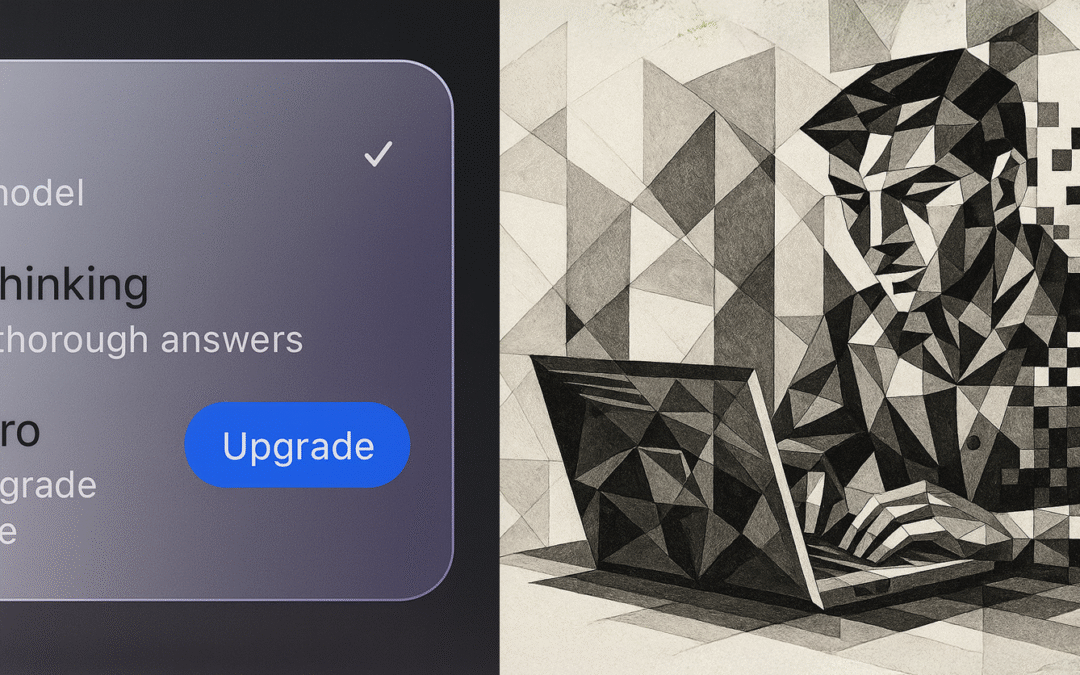OpenAI’s new GPT-5 has arrived, along with other releases from Anthropic and Google DeepMind, all set to shake up how we (and the robots!) interact with AI. How is the new GPT-5? Is it a smoother ride or a frustrating loss of choice for the premium user? Benchmarks say it’s smarter, sharper, and more nuanced, but with other AI giants launching their own upgrades this week, the real question is: is GPT-5 a revolution… or just OpenAI keeping pace? A quick vibe check from a non-technical power user.
Fiona Passantino, AI Professional
Worth the Hype?
The geeks among us may have spent part of our weekend road testing the new ChatGPT-5. What’s new with this release, and is it worth getting excited about?
The short answer is that it’s too early to tell. Simply because it takes time to learn the style of a new model, just as it takes time to adjust to driving a Ferrari after spending a year behind the wheel of a Honda (I love my Honda, by the way).
The biggest change you notice right away, is your new Ferrari is not a manual shift but an automatic. If you’re a premium user, you will go to your upper-right dropdown and find just one, lonely model there instead of seven or eight. You might ask yourself, “where are all the other models?” Where are the Reasoning models, the Quick Thinkers, the Deep Researchers, the Coders, and the Image creators (which you never really knew how to differentiate per project) but that’s beside the point. The new GPT-5 has a built-in intuitive “router” frontal lobe that measures the complexity of your prompt and assigns the model best suited to run.[i] No more manual switching.
For the free users, this feels like a massive win; you simply wake up one day and get a better model, full stop. But for premium users, it feels like we’ve been robbed: all our options have suddenly disappeared, and our beloved manual-shift car has been replaced with an automatic transmission. We are told that “it’s for our own good”.
Actually, this upgrade is more for OpenAI’s own good; a way to keep premium users from sending silly, easy requests to the deep thinking engines that grind through thousands of tokens running on Nvidia’s expensive H200s, lighting up city-sized data centers and burning massive amounts of energy just to produce a few chocolate chip cookie recipes. We were clearly misusing the model and needed to have our keys taken away.
Time will tell if this makes our prompting lives easier or not.

“Cubist Ferrari” prompted by Fiona Passantino, rendered by ChatGPT-5
Benchmark and Vibes
Predictably, the new baby scores higher on all the benchmarks like SWE‑bench (74.9%) and Aider polyglot (88%).[ii] But benchmarks are just a collection of arbitrary tests created by the Tech Bros. A good team of fine-tuners can school any model to perform well if they know the parameters of the test. This is similar to a college student who can cram to pass a statistics exam, but the day after, might be unable to calculate an arithmetic mean from a 2-column Excel spreadsheet.
For programmers, GPT-5 is a better machine, apparently better at tool and function calling. This means it’s able to start an executable programmatic process based on a natural-language prompt. It’s also, apparently, better at debugging. As a non-technical use, I am unable to comment on any of this.
So, what can it do better, faster, or differently? What’s the vibe so far (which is the only metric that matters)?
The writing appears sharper and more articulate. It seems better at understanding nuance and stylized context. There appear to be fewer hallucinations, fewer request declines (which is when a model tells you it can’t tell you the best ways to smuggle cocaine across borders in children’s gummy bears), and when it does decline, the reasons for its refusals are more thoughtful. If that’s any consolation.
The APIs are similarly routed. They now offer flexible tiers: “regular,” “mini”, and “nano” options with their own built-in routers that lead to low-latency “minimal reasoning” or longer, deeper thinkers.
This week has also seen a veritable tidal wave of AI model releases; along with OpenAI’s two new models, Anthropic has unveiled Claude Opus 4.1, Google DeepMind launched Gemini 2.5 Deep Think and Genie 3, a powerful new world model that generates interactive 3D environments in real time. Is this launch more about keeping OpenAI in the headlines?
Time will tell.

“Tokenized” prompted by Fiona Passantino, rendered by ChatGPT-5
Need help with AI Integration?
Reach out to me for advice – I have a few nice tricks up my sleeve to help guide you on your way, as well as a few “insiders’ links” I can share to get you that free trial version you need to get started.

No eyeballs to read or watch? Just listen.
Working Humans is a bi-monthly podcast focusing on the AI and Human connection at work. Available on Apple and Spotify.

About Fiona Passantino
Fiona helps empower working Humans with AI integration, leadership and communication. Maximizing connection, engagement and creativity for more joy and inspiration into the workplace. A passionate keynote speaker, trainer, facilitator and coach, she is a prolific content producer, host of the podcast “Working Humans” and award-winning author of the “Comic Books for Executives” series. Her latest book is “The AI-Powered Professional”.
[i] Mollick (2025) “GPT-5: It Just Does Stuff Putting the AI in Charge”. One Useful Thing. https://www.oneusefulthing.org/p/gpt-5-it-just-does-stuff
[ii] OpenAI (2025) “Introducing GPT‑5 for developers The best model for coding and agentic tasks.” OpenAI website https://openai.com/index/introducing-gpt-5-for-developers/?utm_source=chatgpt.com

